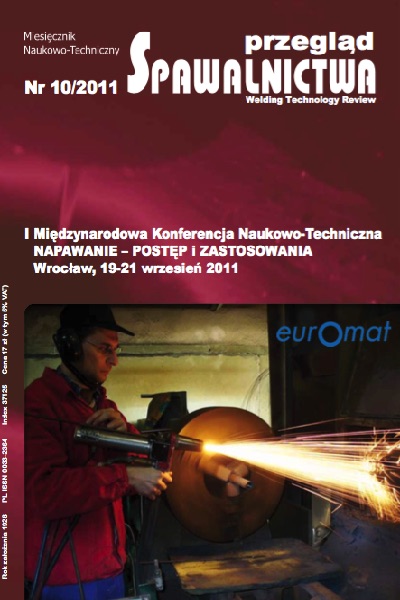Napawanie w regeneracji głowic cylindrowych silników okrętowych
Main Article Content
Abstract
Analizowano możliwości napawania czaszy głowicy silnika okrętowego ze staliwa niskostopowego 13CrMo4-5 nadstopem na osnowie niklu Inconel 625. Zbadano mikrostrukturę, skład chemiczny i fazowy napoin w funkcji parametrów napawania i liczby warstw z zastosowaniem mikroskopii świetlnej, skaningowej i dyfrakcji elektronowej oraz określono rzeczywiste parametry cyklu cieplnego napawania za pomocą analizy termowizyjnej. Określono skład chemiczny i fazowy zgorzelin wytworzonych w wyniku wysokotemperaturowego utleniania napoin.
Surfacing by welding in the regeneration of cylinder head of ship engine
Analysis of ship motor head pad welding method of low alloyed cast steel 13CrMo4-5 by nickel matrix superalloy Inconel 625 have been presented. Microstructure, chemical and phase composition as a function of pad welding parameters and pads number has been investigated using light, electron transmission microscopy, microanalysis, and electron diffraction. Real welding thermal cycle parameters have been estimated by thermovision analysis. Chemical and phase composition of scale generated as a result of the padding welds high temperature oxidation were determined.
Downloads
Article Details
Creative Commons CC BY 4.0 https://creativecommons.org/licenses/by/4.0/
Welding Technology Review (WTR) articles are published open access under a CC BY licence (Creative Commons Attribution 4.0 International licence). The CC BY licence is the most open licence available and considered the industry 'gold standard' for open access; it is also preferred by many funders. This licence allows readers to copy and redistribute the material in any medium or format, and to alter, transform, or build upon the material, including for commercial use, providing the original author is credited.
References
Cho S., Hur J., Seo C., Park S.: High temperature corrosion of superalloys in a molten salt under an oxidizing atmosphere, Journal of Alloys and Compounds, 2008 vol. 452, no. 1, pp. 11-15.
Jarosiński, J.; Błaszczyk, M., Tasak, E., Napawanie stali stosowanych w energetyce stopami na osnowie niklu, Przegląd Spawalnictwa, 1/2007, s. 30-33.
Kohler M., Effect of the elevated-temperature-precipitation in Alloy 625 properties and microstructure, Superalloys 718, 625 and Various Derivatives, 1991, s. 363-374.
Shankar Vani: Bhanu Sankara Rao, K. Mannan, S.L., Microstructure and mechanical properties of Inconel 625 superalloy, Journal of Nuclear Materials, vol. 288, issue 2-3 February, 2001, s. 222-232.
Nowacki J., Wypych A., Problemy zużycia i modyfikacji warstwy wierzchniej głowic silników okrętowych, Przegląd Spawalnictwa 7/2010, s. 2-7.
Nowacki J., Wypych A., Mikrostruktura i odporność na wysokotemperaturowe utlenianie napoin nadstopu Inconel 625 na stali niskostopowej Biuletyn Instytutu Spawalnictwa 5/2010, s. 84-87.
Nowacki J., Wypych A., Zrobotyzowane napawanie stali niestopowych nadstopami niklu, Biuletyn Instytutu Spawalnictwa w Gliwicach, 5/2005, s. 58-65.
Nowacki J., Wypych A., Termowizyjne badania cyklu cieplnego napawania stali niskostopowej żaroodpornym nadstopem na osnowie niklu, Biuletyn Instytutu Spawalnictwa 5/2008, s. 146-151.
Nowacki J., Wypych A., Application of thermovision method to welding thermal cycle analysis, Journal of Achievements in Materials and Manufacturing Engineering vol. 40, issue 2, June 2010, s. 131-137.
Nowacki J., Wypych A., Ocena cyklu cieplnego napawania stali 13CrMo4-5 nadstopem Inconel 625 metodą termowizyjną, Przegląd Spawalnictwa 12/2007, s. 3-7.
